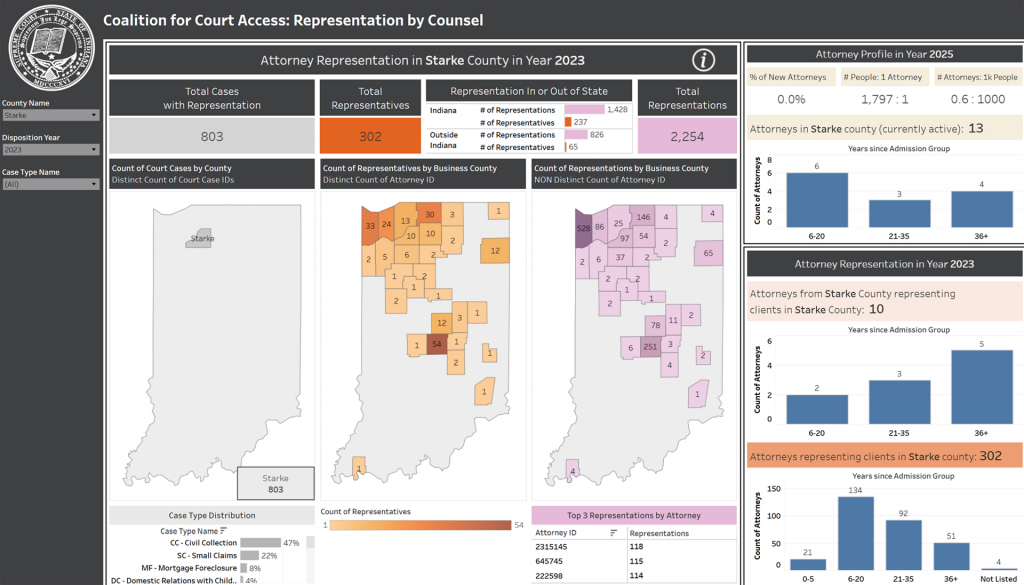By Brendan O’Connor, Director of Data Governance and Analytics | Office of Innovation
and Robert Rath, Chief Innovation Officer | Office of Innovation
Indiana’s trial courts and the Office of Court Technology built a data gold mine with the statewide case management system. Bringing courts and their data together establishes the foundation for more advanced analysis and reporting. Modernizing data tools can allow courts to manage their caseloads more effectively, identify bottlenecks in caseflow, and discover trends or anomalies that would otherwise be impossible to detect. Evidence-based decision making can supersede historical practice. Intention can reinforce intuition. Court management can be more proactive and less reactive.
To this end, the Office of Judicial Administration launched a strategic data modernization program to improve the tools and information available to courts and staff. As part of this effort, OJA is building an enterprise data warehouse: a digital library for organizing, cataloging, and synthesizing court data from a wide range of sources.
A warehouse can store information from many sources: case management, e-filing, roll of attorneys, supervision, and even the U.S. Census or other public databases. This can provide many new ways of analyzing information. Historically, reports have been created from individual systems without the ability to relate data from one system to another. This has led to separate silos of data that don’t automatically connect. On the other hand, a warehouse allows blending of data across many applications to produce reports, dashboards, and more advanced analyses with speed and precision.
Another benefit of a data warehouse is that information can be calculated or estimated in a warehouse without impacting the source system. For example, OJA developed a program that can determine automatically whether parties have represented themselves on a case, even for just a limited time, without requiring special data entry by court staff in the applications themselves. We can also estimate aggregate demographic information about civil case parties without imposing new data collection requirements on litigants or court staff. In the future, we will be able to use predictive analytics to identify potential issues—for example, problems scheduling hearings—and recommend improvements automatically.
More advanced data analytics can help us understand the nature and scope of issues we face. One instance where it can make a large impact is with the Commission on Indiana’s Legal Future. This commission was created by order of the Indiana Supreme Court to explore options for addressing Indiana’s attorney shortage and present findings and recommendations to the Court on future actions. The commission is a strategic response to the critical shortage of attorneys across the state.
Alarmingly, 91 of 92 Hoosier counties report a lower number of lawyers per capita than the national average. This scarcity’s impact is most pronounced in rural areas, economically disadvantaged communities, and within the public service sector. Such a deficiency poses a significant risk to the legal profession’s integrity, undermines public trust in the judicial system, erodes the rule of law, and ultimately impacts the civic health of Indiana’s communities.

The Office of Innovation and the Coalition for Court Access created a dashboard (pictured above) that combines case management, roll of attorneys, and U.S. Census information to better understand the gravity of the legal desert. For example, the dashboard shows that 302 attorneys appeared in 803 civil cases in Starke County in 2023. Of these, only ten attorneys have a business address in the county. The roll of attorneys lists thirteen attorneys with an active license in the county, or 0.6 attorneys for every 1,000 residents. The American Bar Association defines a legal desert as a county with fewer than 1.0 attorney for every 1,000 residents.
The CCA dashboard includes data on self-represented litigants, poverty rates, rural and urban population, and internet access by county. Over time, additional data can be calculated or integrated from other sources into the data warehouse to help judges and administrators tackle problems or develop improvements. The goal is to make the dashboard publicly accessible.
In addition to the CCA dashboard, there are several other projects where the creative use of data assets offers a decision-making advantage for leaders. As an example, judges across the state are exploring ways to improve caseflow in civil, criminal, and family cases. Analyses from the data warehouse can lead to better insights for areas of opportunity. The resulting data solutions and dashboards can display case processing timelines and allow judges to drill down to understand exceptions or delays.
Additionally, organizations like the National Center for State Courts have several projects and proofs-of-concept to help courts understand and use data as an asset to improve their operations, rather than as a burden that must be overcome. OJA is excited to work with judges and stakeholders on this new strategic data modernization program.
Should you have any questions or challenges you would like to discuss, please reach out to [email protected] or [email protected].